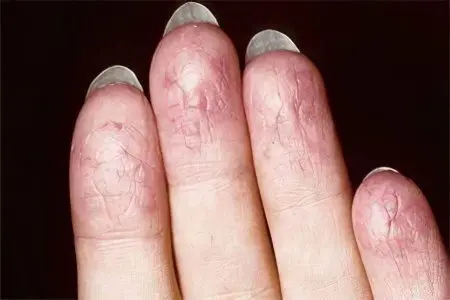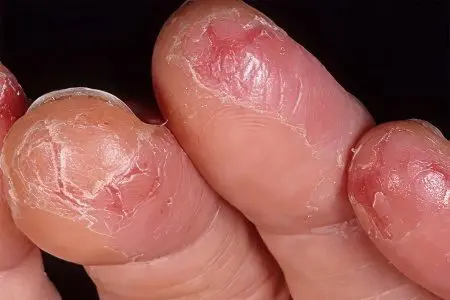Contents

Dyshidrotic eczema on the fingers is an eczematous dermatitis of the skin of the palms, which is chronic and manifests itself in the form of small vesicles filled with serous contents.
Dyshidrotic eczema in 80% of cases affects the skin of the palms, the soles account for the remaining 20%. The disease got its name due to the fact that earlier scientists associated its occurrence with blockage of the sweat glands. Modern medicine has a different view on this problem and dyshidrotic eczema on the fingers is explained by other reasons, since it has been proven that the sweat glands function normally in most patients. If we consider this disease in the general structure of dermatological pathologies, then it is observed in approximately 8% of patients.
The disease is diagnosed in both men and women with the same frequency. However, the age when dyshidrotic eczema affects women most often ranges between 20-25 years, while among men the disease occurs more often around the age of 40 years. In children, pathology is rarely detected. There is evidence that people living in cities have more eczema than people living in rural areas.
Symptoms of dyshidrotic eczema on the fingers
Symptoms of dyshidrotic eczema on the fingers are as follows:
On the skin of the fingers, elements of the rash appear, which look like vesicles. These are small vesicles with transparent serous contents, their size does not exceed 0,5 cm. A hard cover forms on the surface of the vesicle.
Bubbles are located deep in the epidermal layer of the skin. Severe itching precedes the formation of vesicles and accompanies their appearance.
Primary elements appear on the lateral surfaces of the fingers. Subsequently, the rashes are combined into groups, covering the palmar and back surfaces of the hands.
As the disease progresses, the blisters resolve, forming erosions. Erosions are larger than the vesicles themselves, tend to merge after opening. The opening process occurs both independently and due to combing the bubbles.
Over time, erosion heals, and yellowish crusts form on their surface, which can sometimes have a brownish tint.
Subsequently, skin changes characteristic of eczema are observed: it begins to peel off, thickens, turns red, the skin pattern intensifies, cracks form on it.
If pathogenic mycobacteria get into the cracks, then a microbial infection joins. Secondary infection is accompanied by purulent inflammation, called pyoderma. At the same time, purulent pustules form on the skin. Accordingly, there is a violation of the general condition of the patient, the body temperature rises, the affected areas of the dermis swell and hurt, and the regional lymph nodes increase in size.
Most often, dyshidrotic eczema has a chronic course with characteristic phases of remission and exacerbation. The duration of the exacerbation period is several weeks.
Causes of dyshidrotic eczema on the fingers

It has been established that the causes of dyshidrotic eczema of the fingers are:
Endocrine diseases (diseases of the thyroid gland, hypothalamic-pituitary system, adrenal glands, dysfunction of the sex glands).
Diseases of the nervous system. Many patients note that the appearance of dyshidrotic eczema was preceded by severe nervous tension.
Metabolic disorders.
Violations in the functioning of the immune defense.
Contact of the skin of the hands with irritating substances can provoke the disease. These are most often various means of household chemicals.
Hyperhidrosis also contributes to the development of a dyshidrotic form of eczema, when the disease manifests itself due to excessive work of the sweat glands on the palms. Hyperhidrosis often occurs against the background of the lability of the autonomic nervous regulation, or in violation of the functioning of the endocrine glands.
The connection of this skin pathology with food allergies is not excluded. So, on average, 50% of patients are simultaneously diagnosed with bronchial asthma, atopic dermatitis, hay fever. Moreover, there is a hereditary predisposition to such allergic diseases and they can be traced in the anamnesis of the next of kin.
Occupational hazards often cause the development of the disease, when a person at work is forced to deal with various irritating substances. In this regard, the risk group includes cleaners, workers of chemical enterprises, washers, plasterers, painters, car service workers and other employees who have regular contact with aggressive substances.
Irrational intake and use of medicines.
Burns, abrasions, abrasions, hypothermia of the body can become a trigger for the development of dyshidrotic eczema.
Infectious diseases reduce the immune defense of the body and may be indirect causes of the development of dyshidrotic eczema.
Less commonly, the disease develops due to exposure to the skin of the hands of solar radiation.
It is worth noting that up to 22% of all cases of this type of eczema remain with an unexplained etiology, that is, the cause cannot be established. You should not be afraid of the transmission of dyshidrotic eczema by contact or otherwise, this disease is not contagious.
Diagnosis of dyshidrotic eczema on the hands
There are no specific diagnostic methods aimed at identifying dyshidrotic eczema. However, this does not mean that you should not seek the advice of a specialist. The doctor will evaluate the clinical picture, the location of the rashes and will be able to make a preliminary diagnosis. The chronic course of the disease with frequent relapses will only confirm the assumption made.
In addition, differential diagnosis is important, which makes it possible to distinguish this type of eczema from other forms of the disease, with mycotic lesions, contact dermatitis, and palmar-plantar psoriasis. Therefore, the specialist sends the patient for scraping for pathogenic fungi, then the discharged contents of the erosions, or the serous contents of the vesicles, are sown. This allows you to confirm that the disease is not of a primary infectious nature, and if a secondary infection has joined, then it becomes possible to choose the right treatment.
It is strongly not recommended to self-diagnose and even more so to begin treatment without visiting a specialist. In addition to aggravating the course of the disease, such amateur activity can lead to a distortion of the clinical picture characteristic of dyshidrotic eczema. This, in turn, can lead to medical error and improper therapy.
From mycosis of the skin of the hands, dyshidrotic eczema is differentiated exclusively in the laboratory. A combination of two types of disease in one patient is not excluded.
Treatment of dyshidrotic eczema on the hands
Treatment of dyshidrotic eczema on the hands will be successful only if an individual approach is taken to the patient. There are many methods of dealing with the disease, but it is important to choose one that will directly affect the cause of its occurrence.
Before starting therapy, the doctor detects and eliminates all foci that could serve as provoking factors. These are scars left after injuries, chronic diseases, diseases of the nervous sphere, pathologies of internal organs. You should also get rid of external factors that could cause the disease.
So, the beginning of therapy should be based on the identification and elimination of such pathological conditions as:
Diseases of the central nervous system;
Failures in neurovegetative regulation;
Malfunctions of the digestive tract;
Hormonal dysfunctions;
Failures in the excretory system;
Immune disorders;
Metabolic disorders.
Therapy should be comprehensive, and emphasis should be placed both on the treatment of skin manifestations and on the elimination of dysfunctions of the body as a whole. The selection of course therapy is based on the presence or absence of pyoderma, on the appearance of the rash. Skin manifestations with successful treatment should be completely eliminated.
For this, appoint:
Sedative and antiallergic drugs. Sedatives are prescribed to normalize the patient’s sleep. Antihistamines allow you to cope with itching, relieve allergic manifestations.
Local preparations. With dyshidrotic eczema, several external preparations are not prescribed at once, since some patients have hypersensitivity to most drugs. If intolerance occurs, then it will be quite problematic to determine to which agent it reacted. In addition, ointments are applied to a small area of uXNUMXbuXNUMXbthe skin, if inflammation does not occur, then it is used throughout the affected area.
Antibacterial ointments are used only if the disease is complicated by a secondary infection.
Ointments based on corticosteroid hormones are advised to use only against the background of painful cracks and erosions. Pulse therapy with similar agents is recommended, since their prolonged application can provoke the development of side effects, up to tissue atrophy.
Physiotherapeutic methods of treatment. Physiotherapy for dyshidrotic eczema on the hands is used quite widely. Methods such as: ultrasound therapy, laser and magnetotherapy, thalassotherapy, darsonvalization, acupuncture, electrosleep – all of them help to strengthen the immune system, reduce the amount of drugs used. Doctors strongly recommend that their patients relax in sanatoriums and resorts, take mineral, hydrogen sulfide, mud, radon, salt baths.
Taking vitamins. With the dyshidrotic form of eczema, it is recommended to take vitamins A, E, group B. It is possible to prescribe vitamin complexes.
Prevention of external influences on the skin of the hands. If the patient has to come into contact with chemicals, hands must be protected with rubber gloves, and under them it is best to wear cotton gloves. This will avoid the formation of excess moisture and maceration of the skin.
The best way to wash your hands is considered to be baby soap, or specialized hypoallergenic products. Bed and underwear should be thoroughly rinsed so that there are no traces of powder on it.
Compliance with a diet. An important rule that is used when compiling the menu is the elimination of all potential allergens from the diet. It is necessary to reduce the amount of salt, exclude semi-finished products, as well as food containing a large amount of easily digestible carbohydrates: sugar, honey, pastries, confectionery. Eggs, strawberries, citrus fruits, chocolate are eaten with caution (more on the diet for eczema).
Perhaps the patient will need the help of a psychologist to cope with the psychological discomfort caused by the disease.
[Video] Dr. Evdokimenko – Psoriasis, ECZEMA, diathesis, DERMATITIS, colds and VIRUSES = 1 simple treatment:









